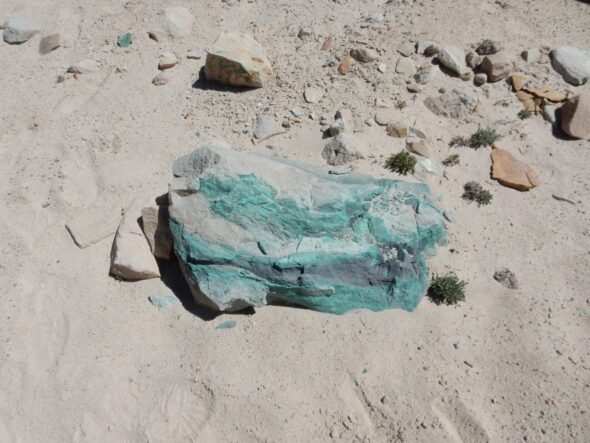
With LAGS at the Nacimiento Mine
The Los Alamos Geological Society held their April field excursion at the Nacimiento Mine, not far from Cuba. We’ve been here a couple of times before, but the mine is a pretty fascinating place, and there are a variety of minerals specimens that can be collected here.
I ride with Gary Stradling. He had the bad fortune to get caught in a traffic jam on I-25 coming back from Albuquerque Friday night, and when he tried to divert through Jemez Springs, he was turned back at a roadblock due to a wildfire. He didn’t make it home until midnight, so we are a bit late getting off Saturday morning. We arrive at the gates of the mine at about 9:20, and find another car also waiting there.
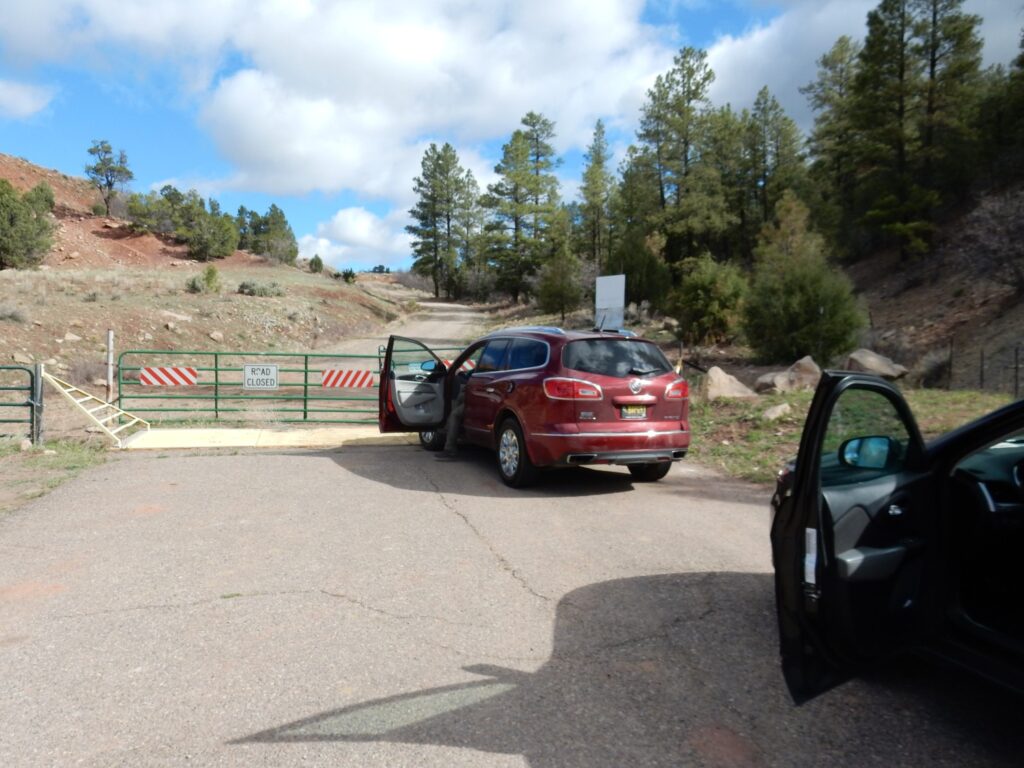
The gate appears to be closed. We wonder if everyone else was late, too, due to the forest fire blocking the direct route through the Jemez. I take a few pictures of the nearby area.
Looking back down the road.
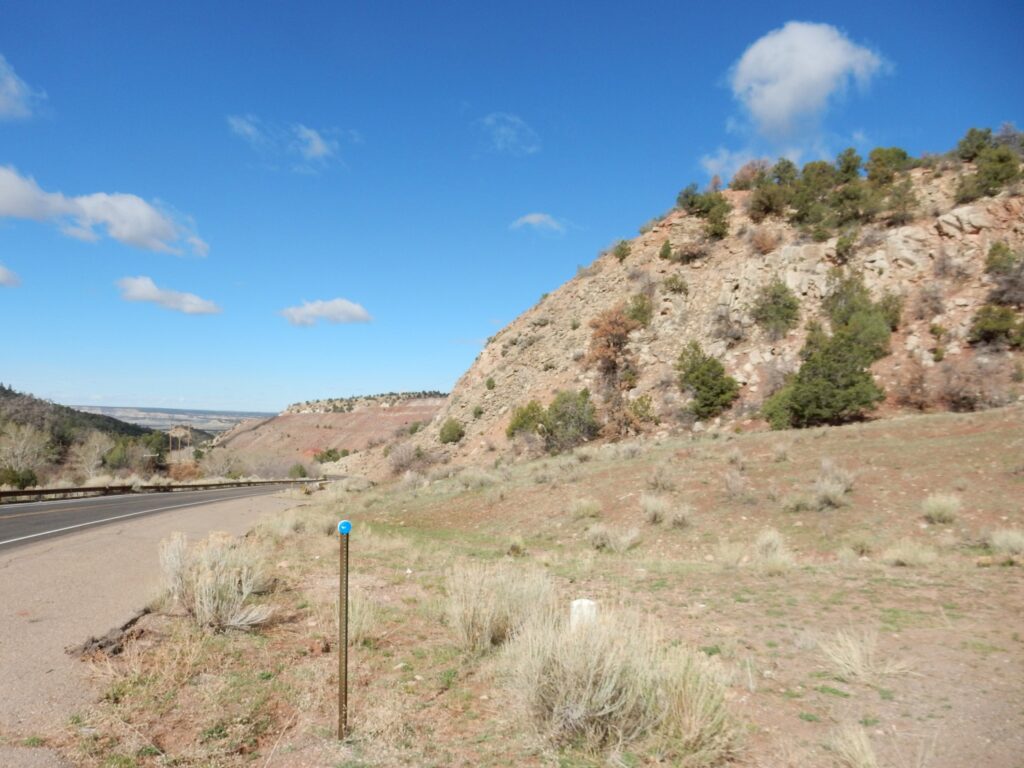
There’s a lot of stratigraphy here. The Nacimiento Mountains just to the east were pushed up relatively recently in geologic terms, less than 25 million years ago, and thrust to the west. This has essentially plowed up and tilted the beds to the west to where they stand at a steep angle.
The nearest ridge, at right just in front of the camera, is a ridge of Poleo Formation. The Poleo is part of the Chinle Group, deposited in a great river valley during the Triassic Period, roughly 220 million years ago. The Chinle River flowed from the young and rugged Appalachians (then part of the Central Pangean Mountains) to the Pacific coast, then in central Nevada, forming a river system comparable with the largest river systems of today. Either the Chinle River or one of its major tributaries passed very close to the Jemez and deposited great beds of sediments.
The red beds beyond are a tailings pile of the Nacimiento mine. Just peeking over them is the top of the Dakota hogback, a ridge of resistant Dakota Formation sandstone of Cretaceous age, around 100 million years old. This was deposited on the beaches of the Western Interior Seaway, a shallow sea that covered most of central North American and stretched from the Arctic to the Gulf of Mexico.
In the distance is Mesa Portales.
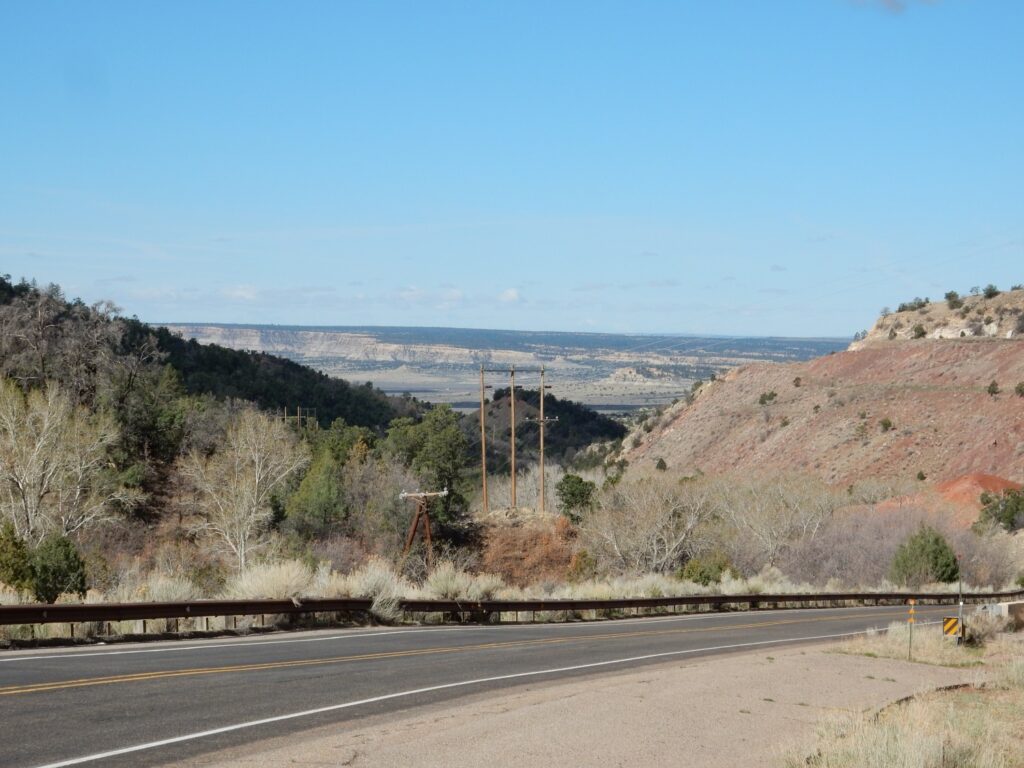
Mesa Portales is capped with still younger Ojo Alamo sandstone, deposited at the Cretaceous-Paleogene boundary, 66 million years ago. Under the resistant cap are soft mudstones of the Kirtland and Fruitland Formations of late Cretaceous age. The Fruitland Formation is a major source of coal in the Four Corners area, and both formations have yielded dinosaur fossils.
Up the road is the Shinarump Formation, lying atop Yeso and Abo Formations.
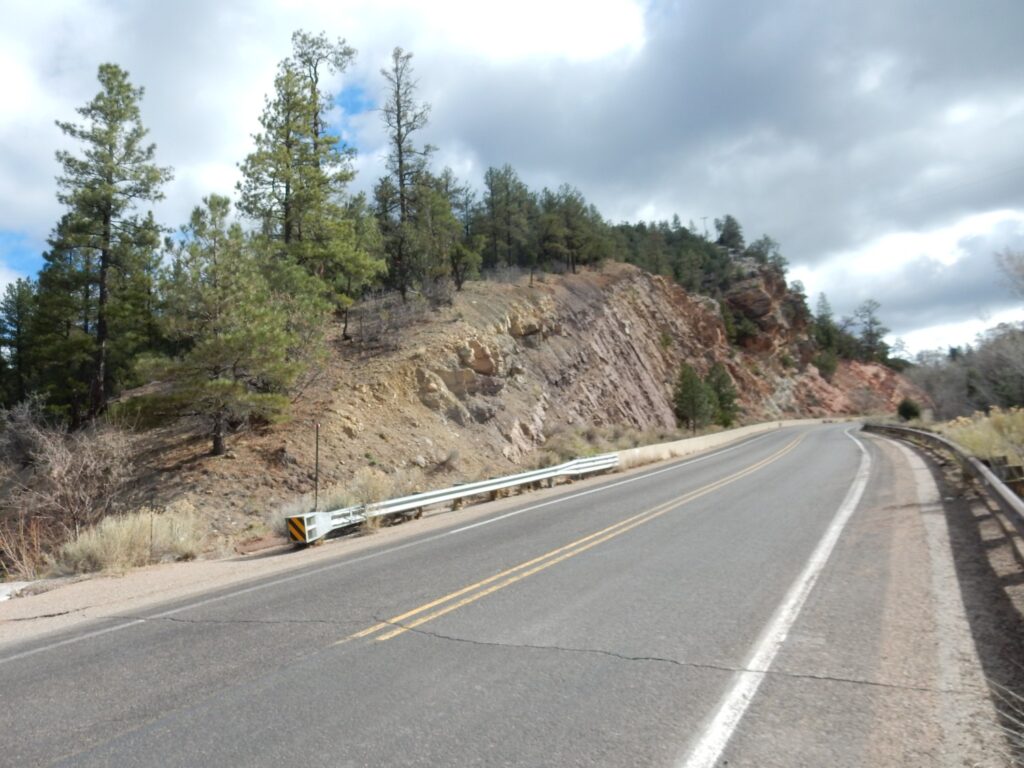
The Yeso and Abo are the red formations further from the camera. The Shinarump is a conglomerate and sandstone formation that is light tan in color. The Shinarump is also the host formation for the copper ore deposits that were once mined here, and from which we will be collecting most of our specimens today. It is the oldest formation in the Chinle Group almost everywhere the Chinle Group is found, while the Yeso and Abo are Permian formations, dating back to around 290 million years old.
I hike up the road to check, and find there are seven cars parked inside.
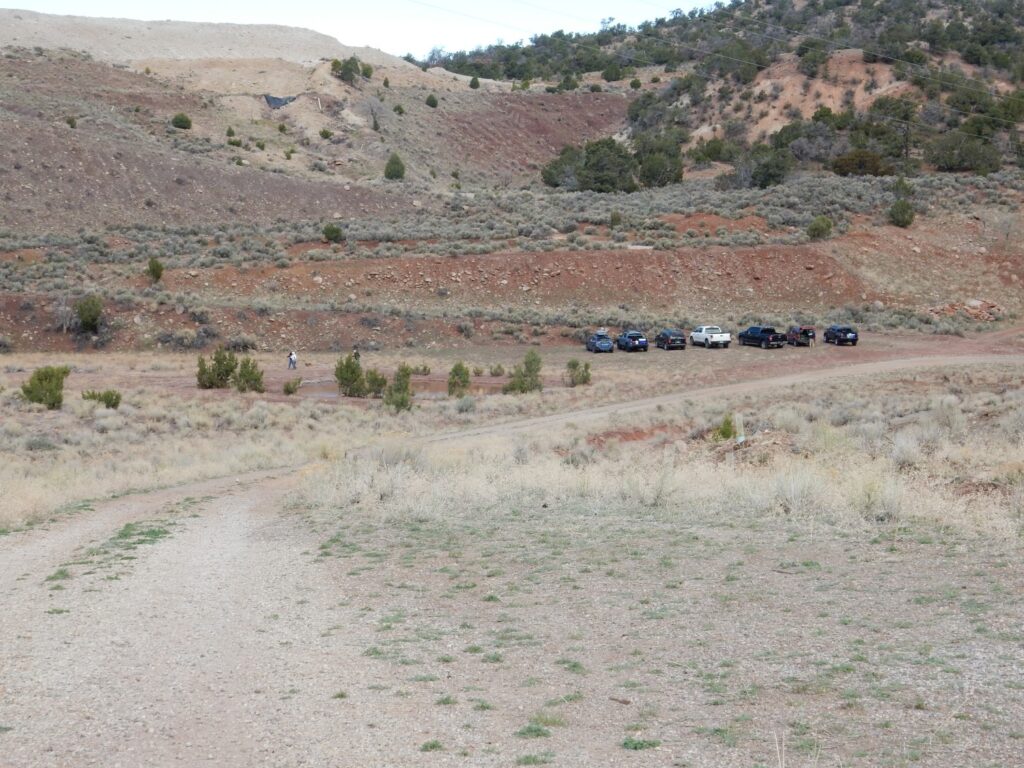
I’m sorry to miss Patrick Rowe’s introduction to the area, but I’ve heard it a couple of times before and give a quick summary to the (now) three carloads of visitors waiting at the gate. We hike in and head for the lower tailings pile.
Some 230 million years ago, a forest fire in the conifer forests of the Triassic led to flash flooding, and a great logjam of charred wood accumulated in a river channel of the Chinle River system. This was almost immediately buried by mud, preventing the wood from rotting quickly. Groundwater percolating through the ash-rich mud picked up copper and other heavy metals, which were relatively soluble in the oxygen-rich water that flowed through the porous sand of the Shinarump Formation. But when the water reached the logjam, the slowly rotting wood consumed all the oxygen in the water, reducing sulfate ions to sulfide.
A brief digression: You’ll hear geochemists talk about oxidizing versus reducing conditions. This terminology goes clear back to the medieval alchemists, who reduced ores to the metals they contained, usually by removing oxygen from the ore compounds. Oxidation comes from oxide, a word whose roots are the same as acid, reflecting a tendency for compounds containing oxygen to dissolve in water to form acids. So oxidizing conditions are conditions in which oxygen is abundant and oxygen-containing compounds tend to form, while reducing conditions are conditions in which oxygen is scarce and oxygen-containing compounds tend to break down. The rotting wood of the Shinarump logjam produced reducing conditions.
The sulfide reacted with the copper in solution to form extremely insoluble copper sulfide. This was deposited in place of the wood as a black mineral called chalcocite. Some iron sulfide was also deposited as pyrite, and traces of silver were reduced to the native element. All these are found at the Nacimiento Mine, though chalcocite predominates and native silver is present only as small particles here and there in the chalcocite.
Petrified wood formed by impregnation with chalcocite is highly unusual. Wood normally becomes impregnated with silica, sometimes along with iron minerals, forming the familiar reddish petrified wood found in the Petrified Forest in Arizona. (Which is also part of the Chinle Group.) The unusual chalcocite permineralization of the petrified wood at the Nacimiento Mine likely is a result of the wood being partially burned. There is evidence that charred wood does not take up silica as well as uncharred wood, but has a greater tendency to accumulate heavy metals.
Later, as the Nacimiento Mountains were pushed up, the ore beds were exposed to fresh oxygen, and some of the copper sulfide was oxidized to copper hydoxycarbonate minerals — malachite, a bright green mineral, and azuite, a deep blue mineral. So the usual pattern is to find chunks of black petrified wood (impregnated with chalcocite) surrounded by stains of green and blue (malachite and azurite).
The lower tailings pile.
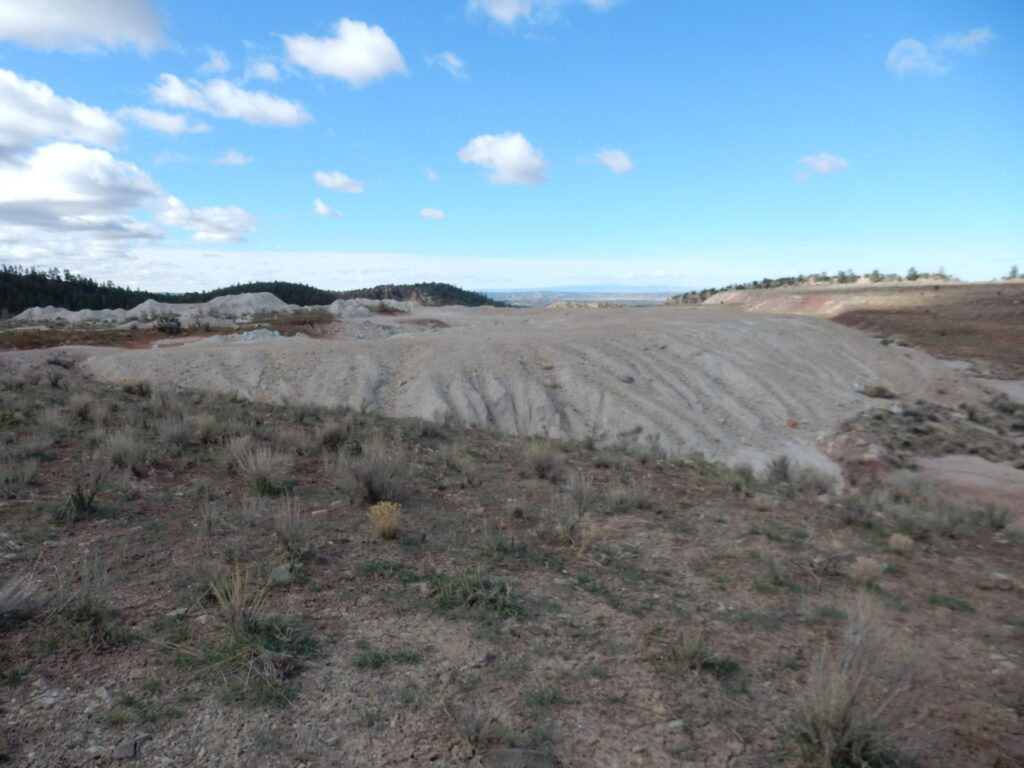
This is mostly fine sand, left after the Shinarump ore beds were crushed and the valuable ore particles extracted using floatation recovery. The crushed ore was fed into tanks of water through which air was bubbled. The sulfide minerals clung to the air bubbles and were floated to the surface to be removed, while the useless sand settled to the bottom and was removed to the tailings piles. Special surfactants were developed that caused the malachite and azurite to cling to air bubbles as well, allowing most of the copper to be extracted. However, some ore was inevitably missed, and fragments can be found around the edges of the piles.
Such as these.
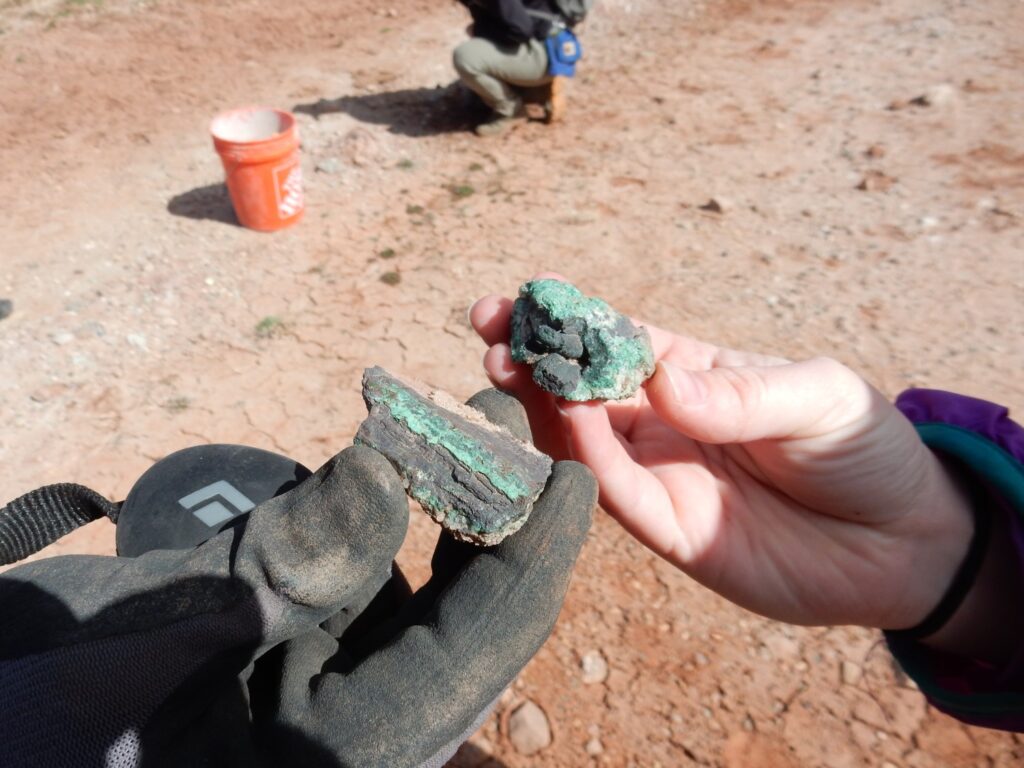
It did not take long to find these. Very lucky (or determined) collectors sometimes find much larger fragments. Patrick Rowe recently found one weighting 35 pounds.
Another visitor finds a “blueberry”.
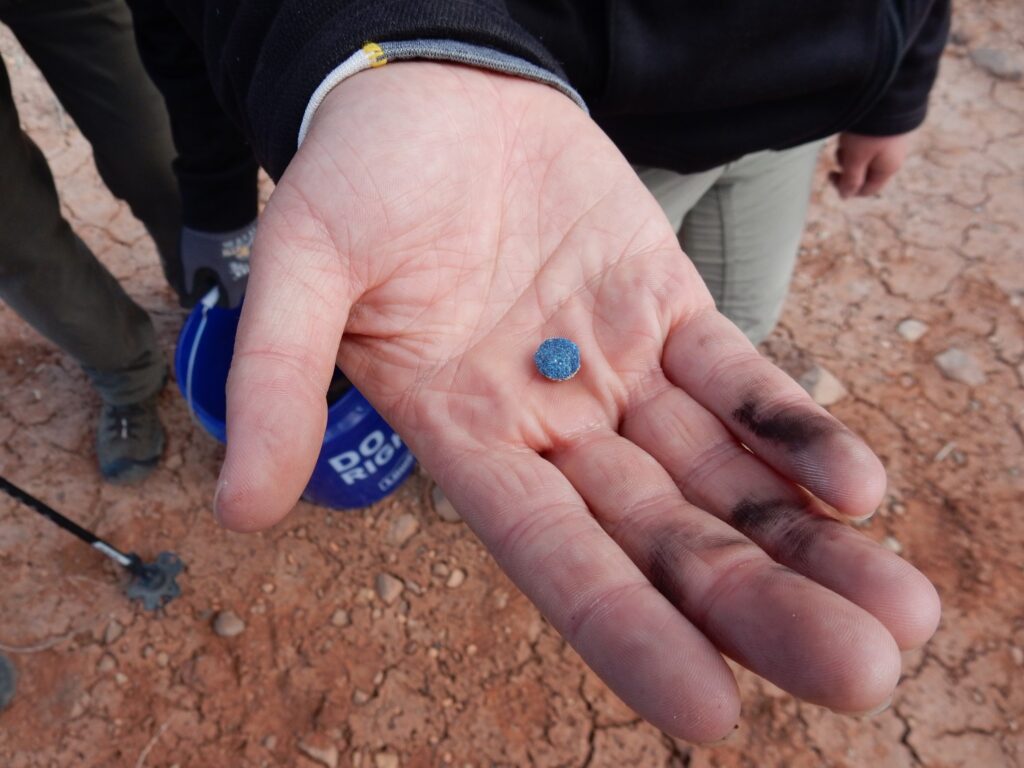
This is a concretion of azurite that cements a small ball of sandstone together. These likely form in disturbed areas; some may be no older than the mine workings here.
Scouring the area.
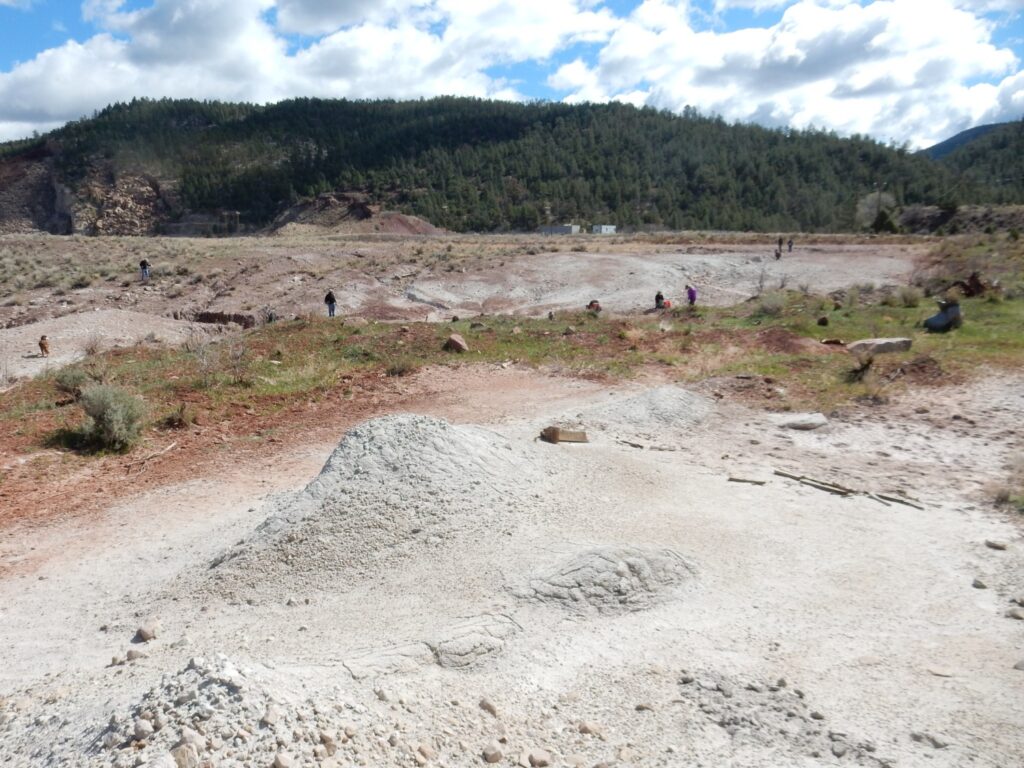
Gary digging through the tailings. That’s my pitchfork in the foreground; it turns out I didn’t dig up much worth keeping.
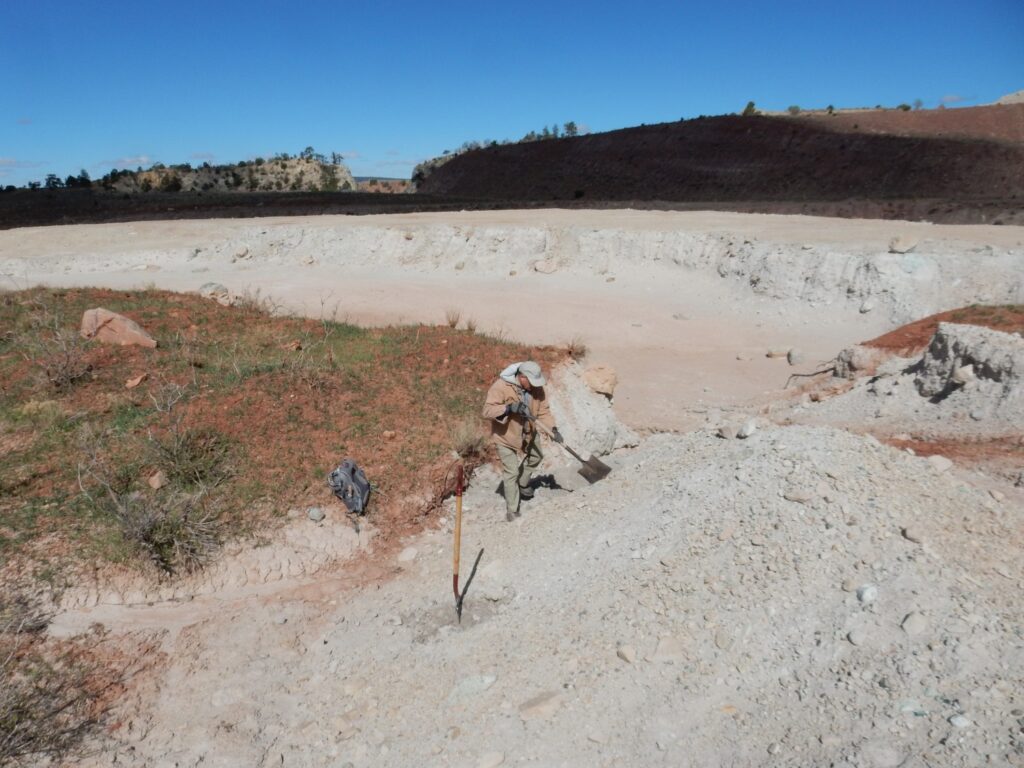
The notch in the background ridge is artificial, providing a path for taking crushed ore to the flotation separator, which was further west.
Copper-saturated boulder.
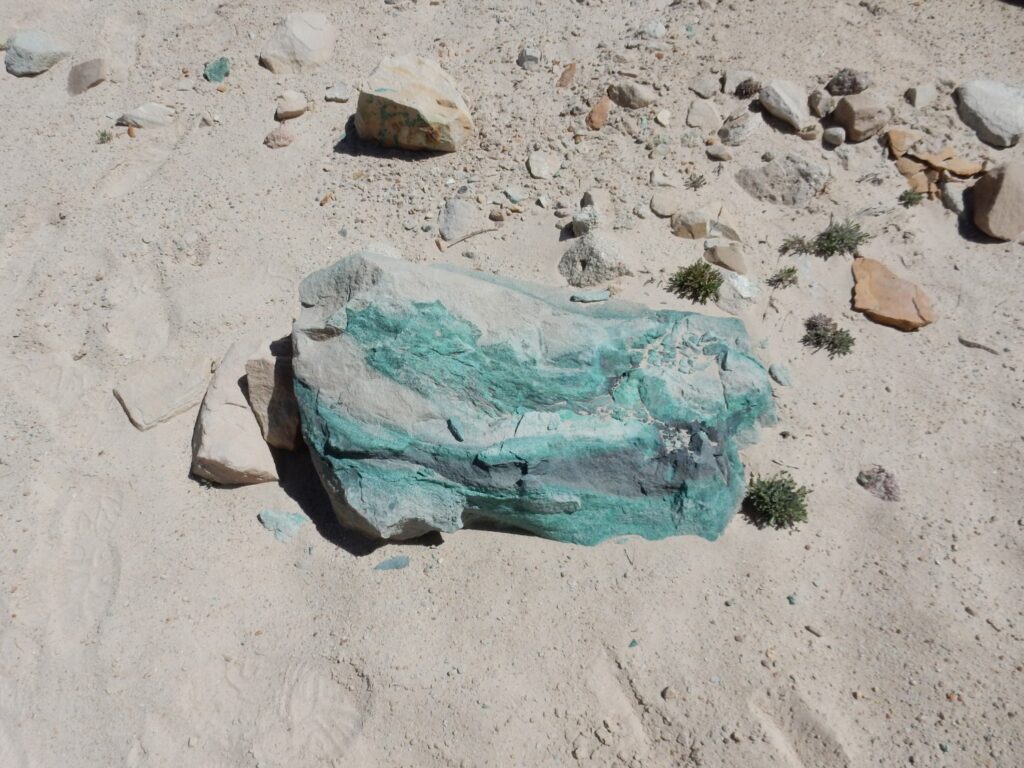
Would make a nice yard rock, except it’s probably a couple of hundred pounds and there’s no way to bring a vehicle up close.
Conglomerate boulder with some copper mineralization.
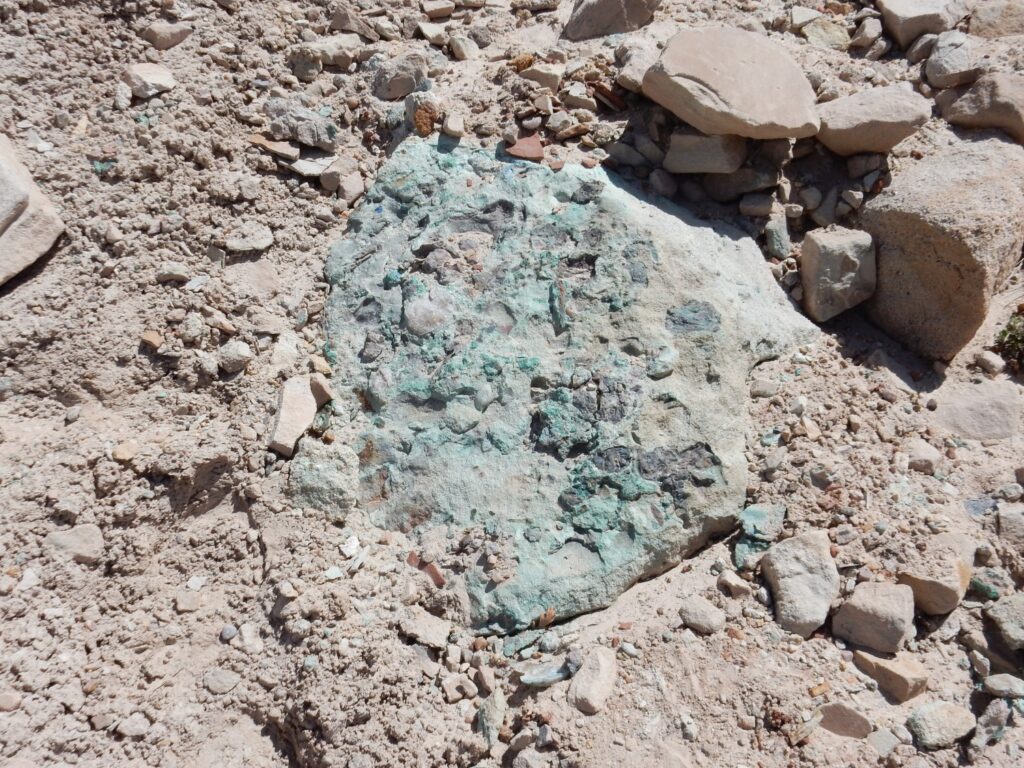
Boulder with fragments of petrified wood and copper mineralization.
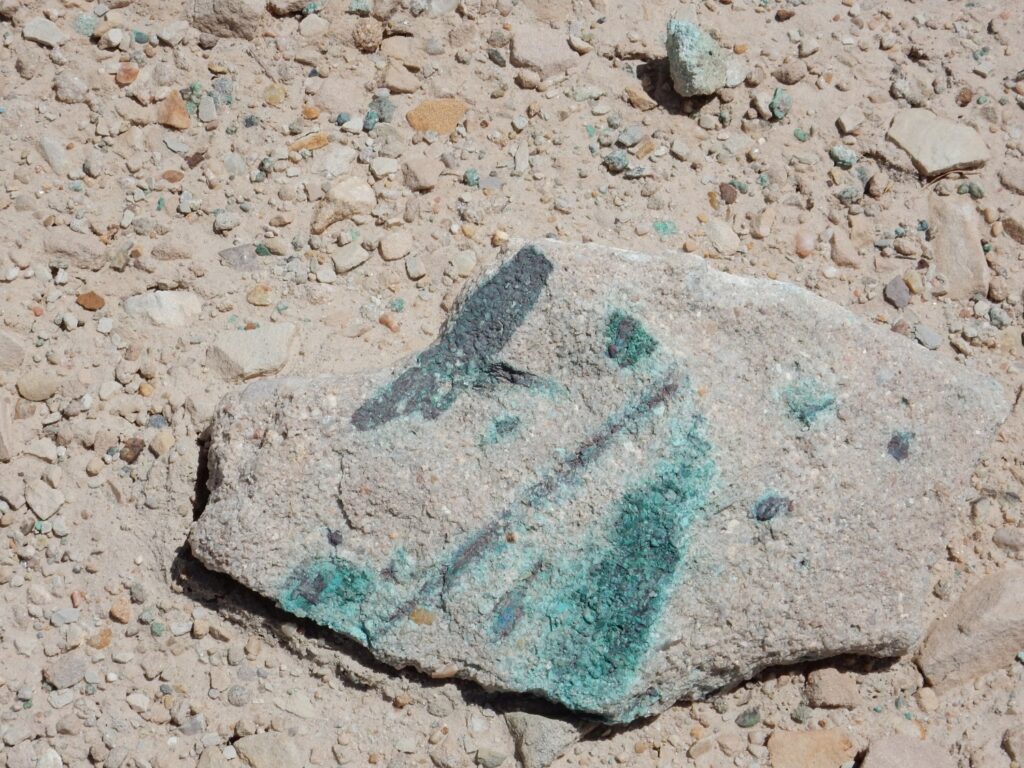
Gart, Patrick, and a couple I don’t know (I believe they’re from the Albuquerque club.) In the background is the open pit.
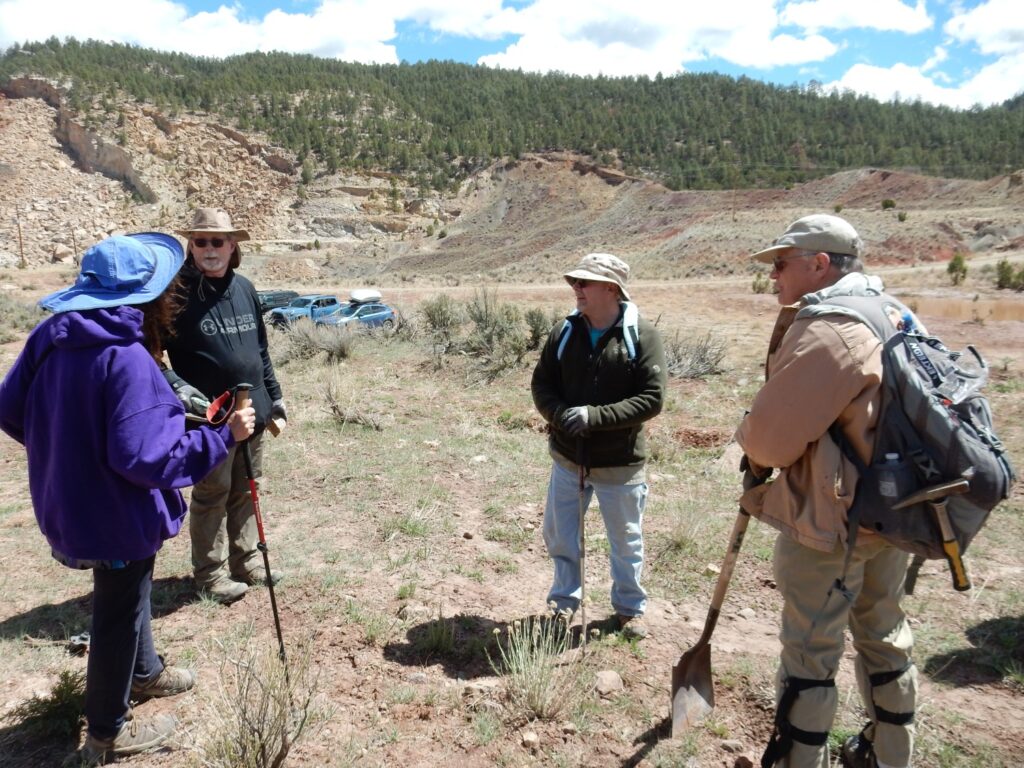
Picking over the upper tailings pile.
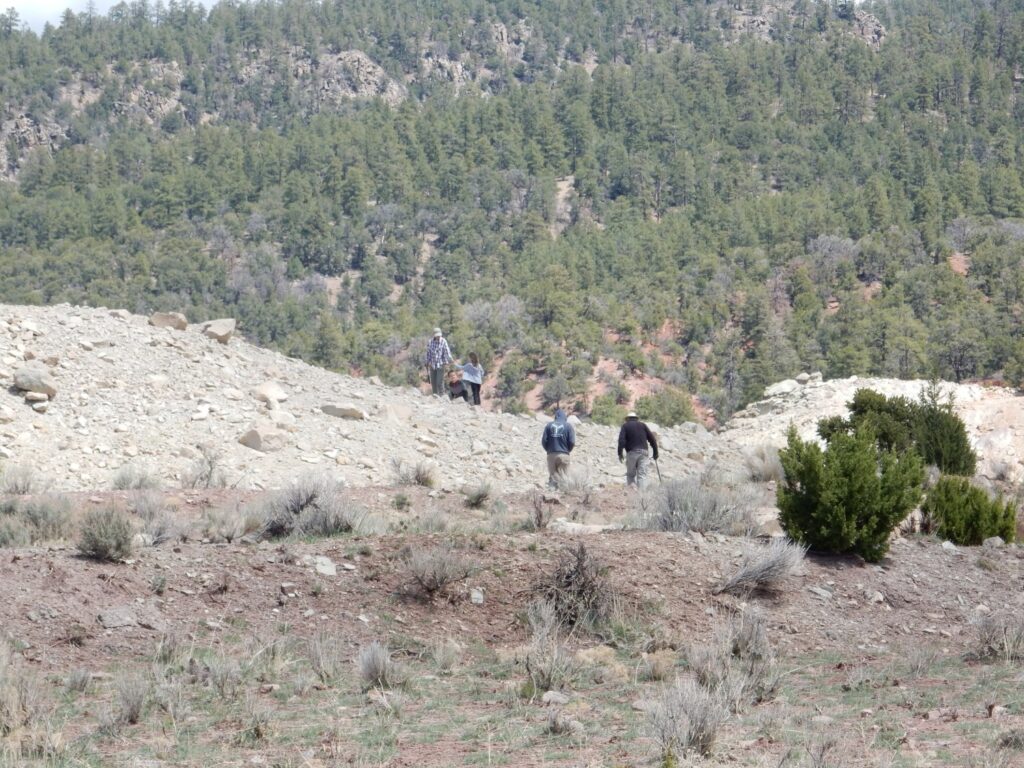
Patrick takes a group of us to a spot on the upper tailings where he has had some luck finding good specimens. I do find some nice pieces, and nearby is a good spot for photographing the surrounding landscape.
Mesa Portales. In the distance is a volcanic neck — I’m not sure which one.
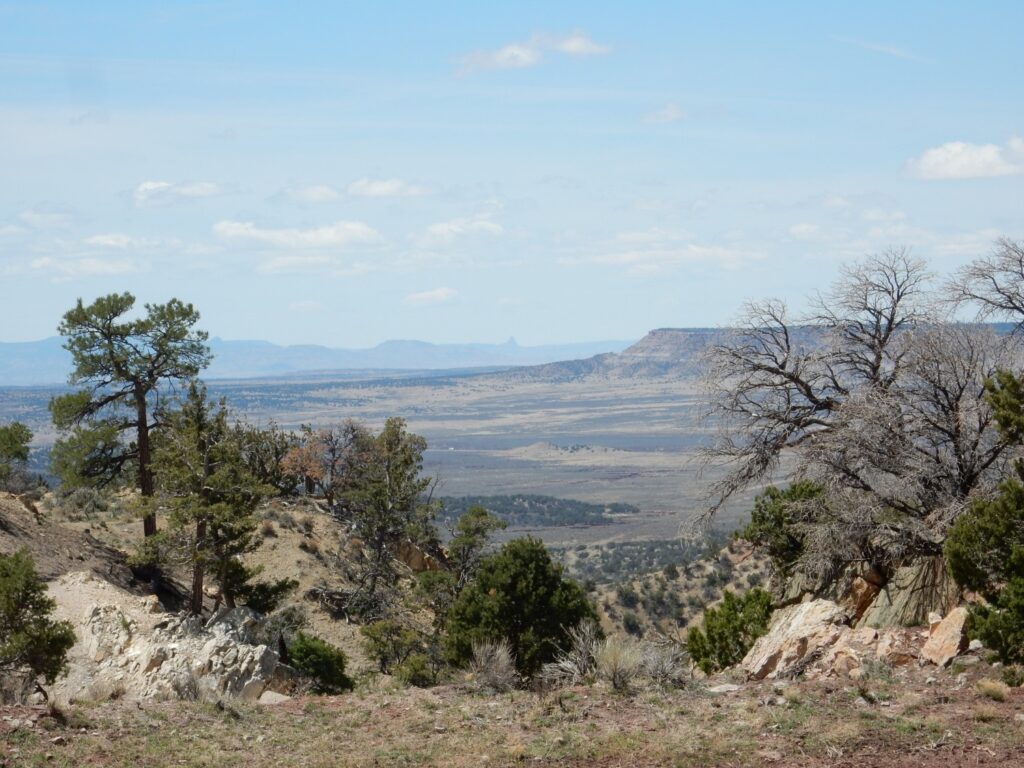
Cabezon Peak and other nearby volcanic necks
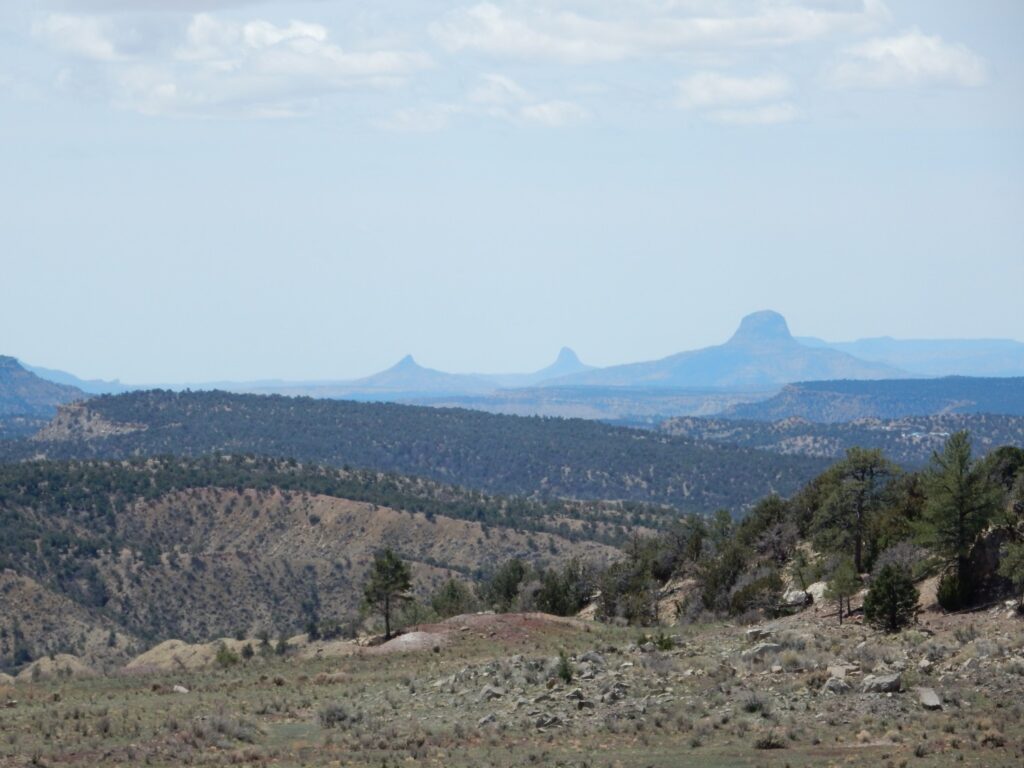
These are part of the Mount Taylor volcanic field. They were cinder cones, with walls of loose and easily eroded cinder around a central hard plug of solidified lava.
Oooo.
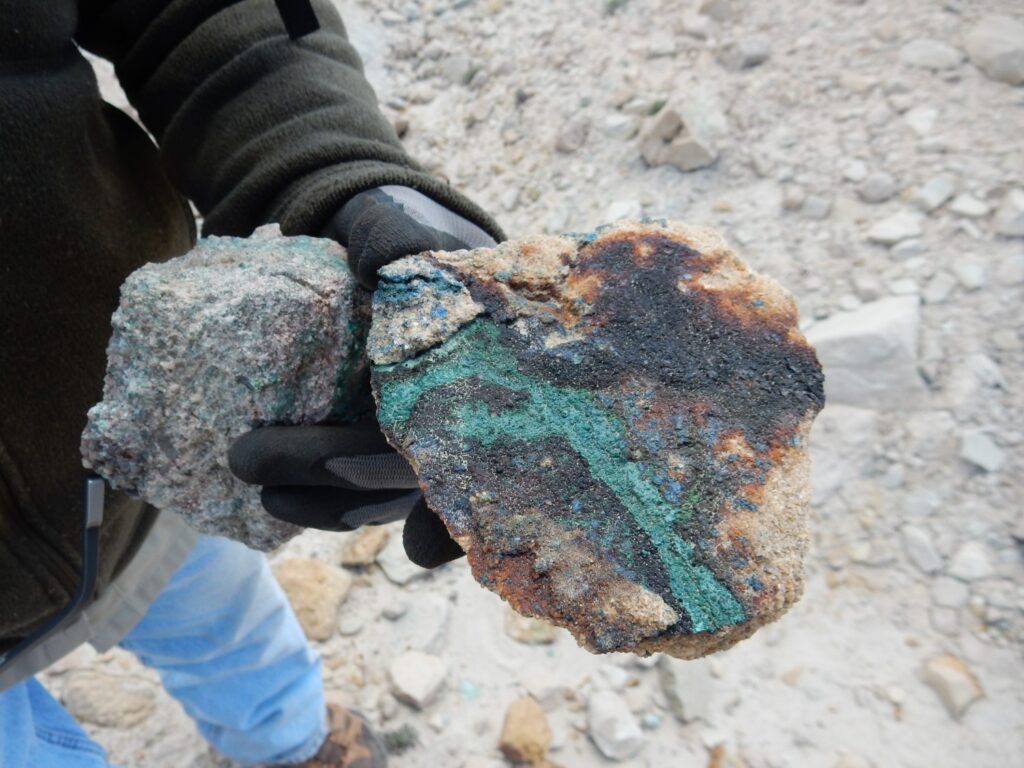
Mesa de Cuba.
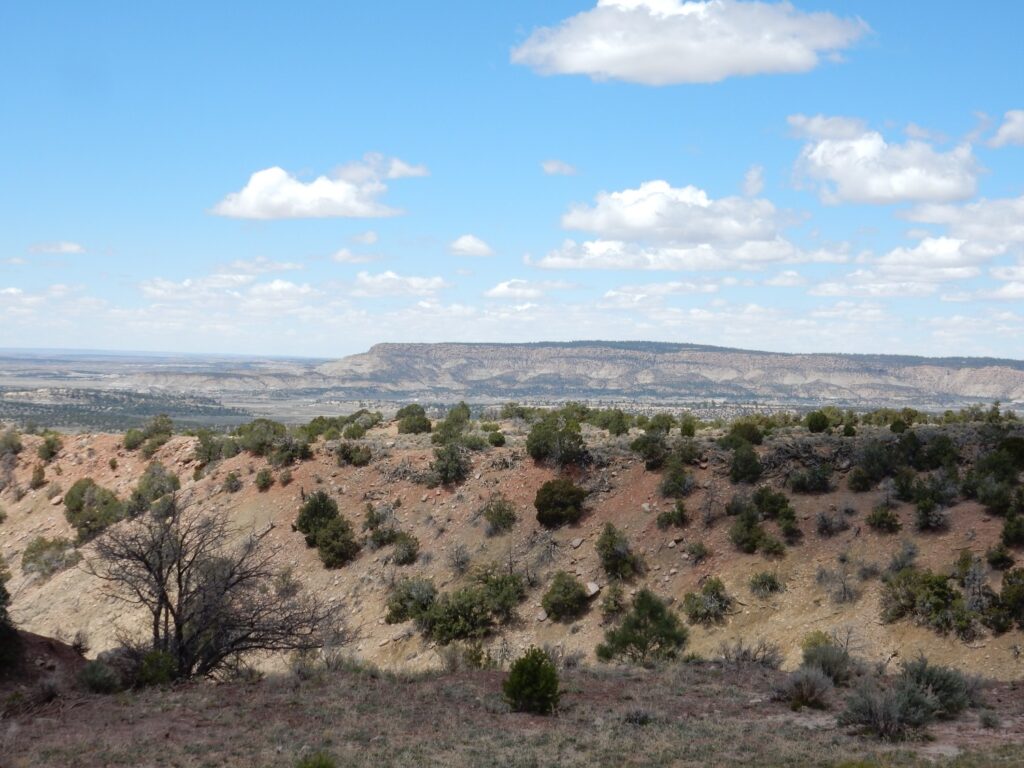
The mesa is capped with San Jose Formation sandstone, under which are soft slopes of the Nacimiento Formation. The Nacimiento Formation is Paleocene and the San Jose is Eocene, one of the many Eocene redbed sedimentary formations of New Mexico.
In late 1874, Edward Drinker Cope explored the area north of the San Pedro Mountains, where fossils had been reported. North of Regina, he found early Eocene fossils in the badlands and spent about seven weeks collecting fishes, reptiles, and what was then the oldest known mammal fossils in North America. He also collected the fossil of a giant flightless bird. This proved to be one of the most important fossil finds for life in the early Eocene in North America, which Cope wrote to his father was “the most important find in geology I have ever made”. However, Cope was unable to find anything but a few bits of petrified wood in the underlying beds of the Nacimiento Formation, which he named the Puerco Marls.
Curious pattern on the copper mineralized face of this rock.
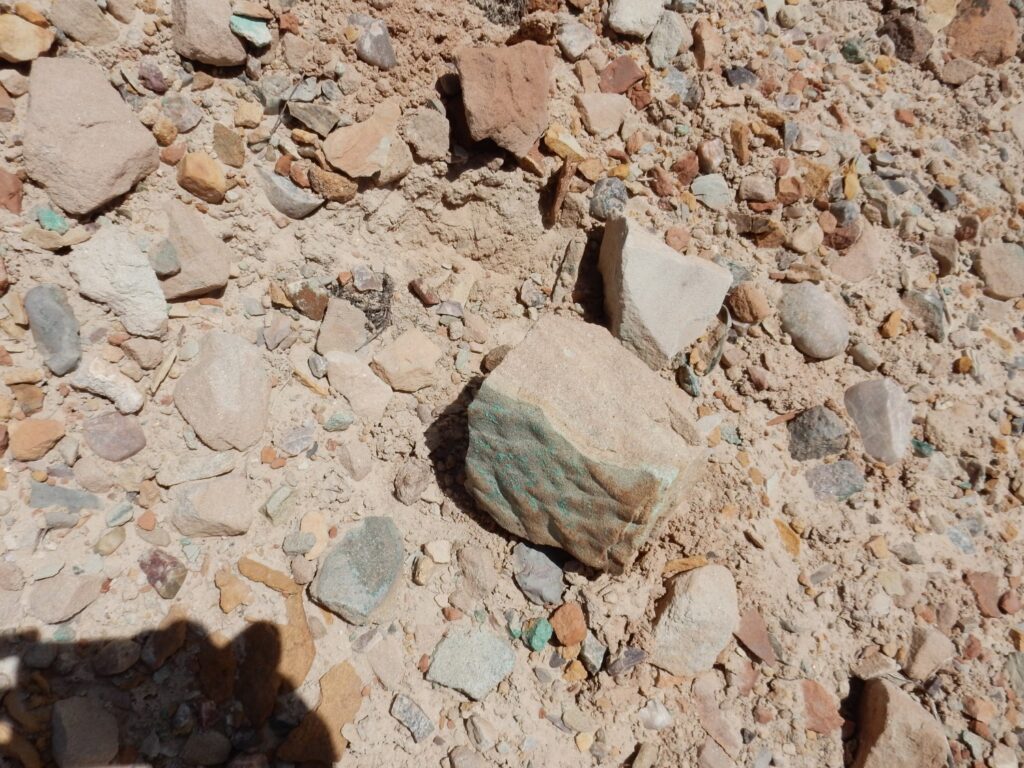
We eat lunch, the Gary and I linger to explore the open pit.
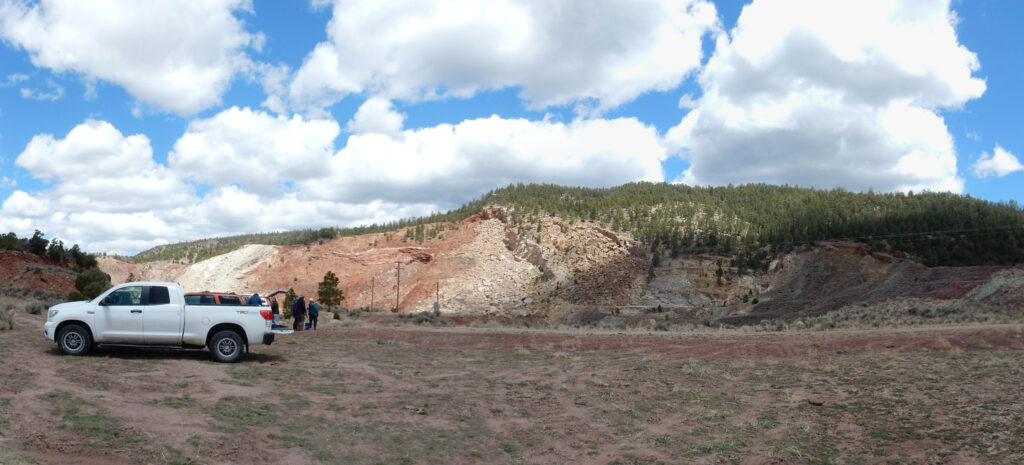
I didn’t get a proper panorama this trip, but from an earlier visit:

The mine was originally mined from adits, horizontal tunnels into the ore bodies. The upper parts were soon exhausted, and mining continued in an open pit. This became uneconomical due to the cost of pumping water out of the pit, and also because an earthquake shook loose the debris you see on the other side of the lake. Clearing the rubble and stabilizing the slope against further earthquakes was just prohibitive. However, someone came up with the clever idea of drilling down into the ore body, pumping it lots of sulfuric acid, and leaching out copper.
It didn’t work.
We’re now dealing with how to clean up the mess. (I say we because apparently this is a Superfund site.) What is being done — apparently with some success — is to flush water through the ore deposit, to remove the sulfuric acid, and then pump the heavy metal-laden water into a closed pit. This is fed alcohol, which promotes growth of anaerobic bacteria. These convert the sulfate into sulfide, in effect duplicating the original natural process for forming the ore. The sulfide precipitates out the heavy metals and leaves the water clean. However, the excess sulfide does make for quite a stench by the pumping plant.
Stratigraphy: The red shelving beds to the right are Salitral Formation, while the white rock (mostly mined away) on the far side of the lake that now fills the open pit is Shinarump Conglomerate. The red beds exposed beneath are Yeso and Abo Formations.
Patrick gives us directions to the interesting stuff. It turns out there are a couple of sets of claims here. One set is off-limits for us to collect, but we have special permission (only for our group and only for this day) to collect off the surface on the other set of claims. Gary and I hike that way, pausing to admire some conglomerate.
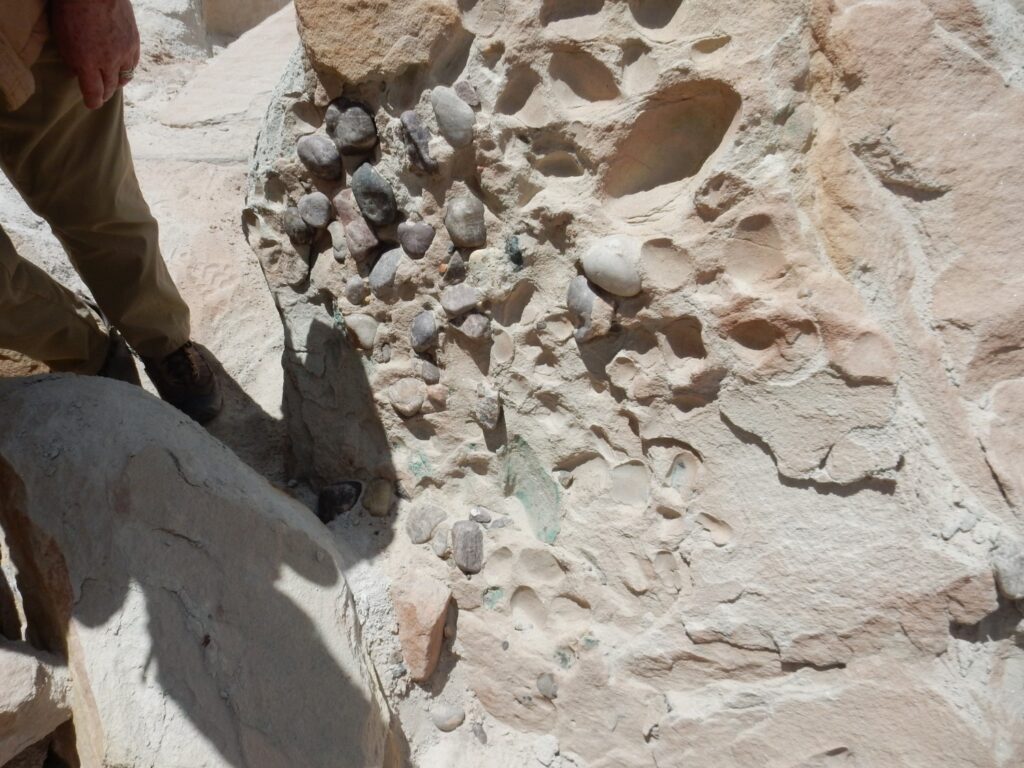
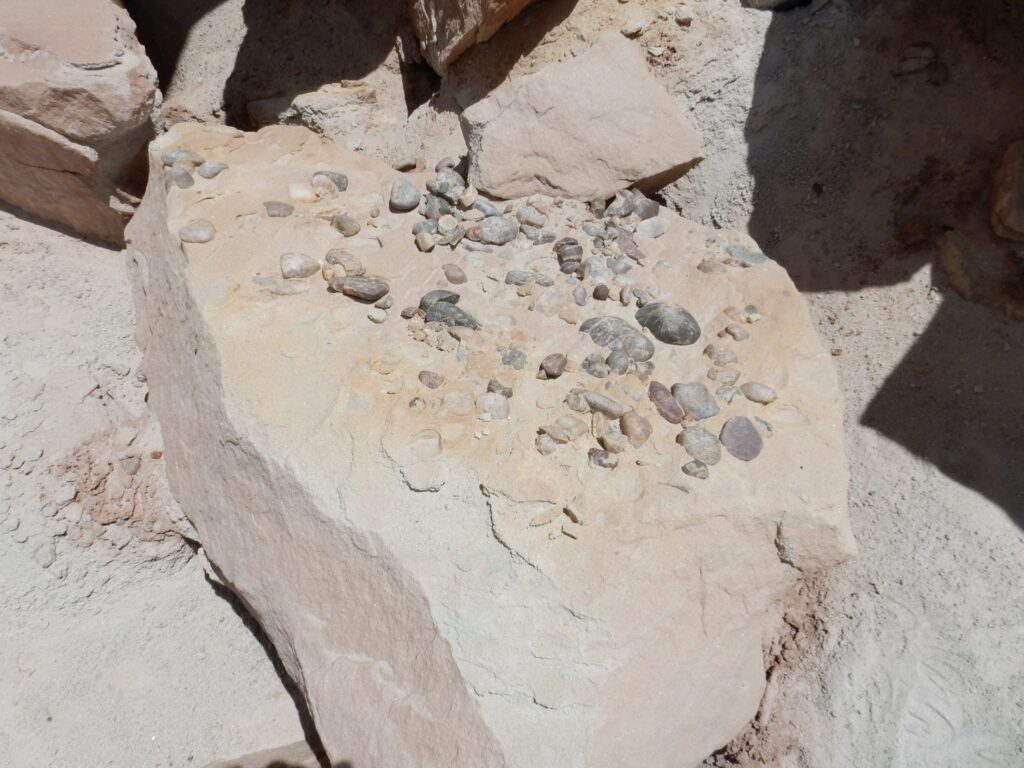
This turns out to be from a single thin bed of well-polished large stones in the midst of the Shinarump sandstone.
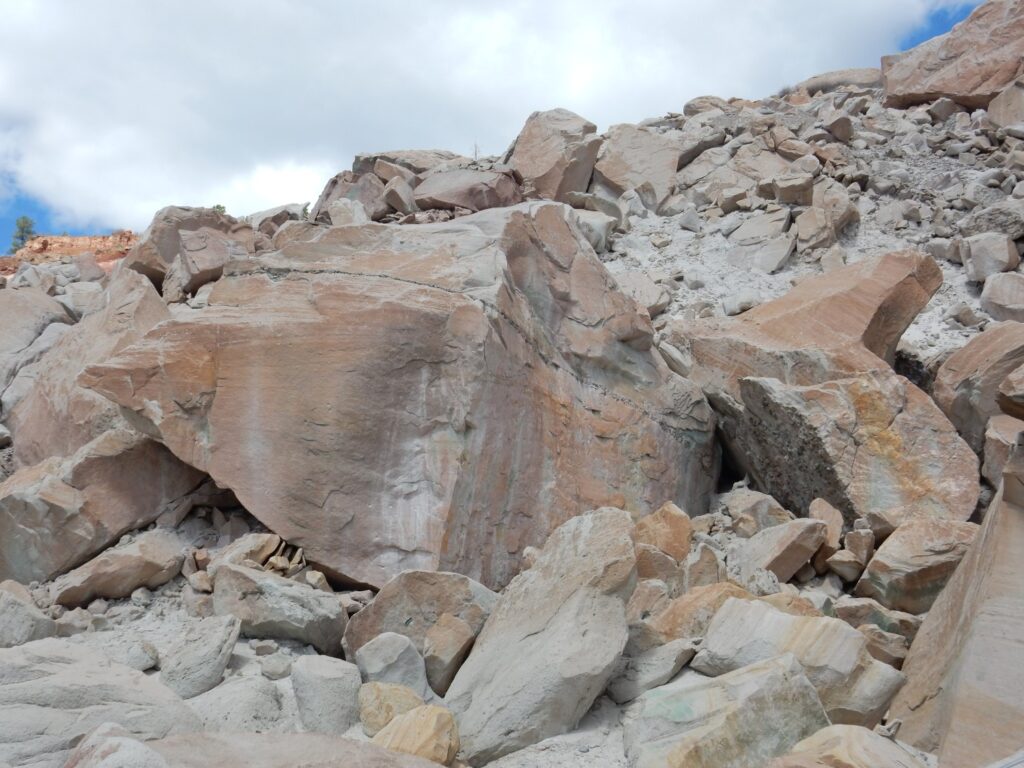
The bed is the very thin dark layer cutting across this house-sized boulder.
We come to a ramp of gray rock that we were told we should climb to get to the best stuff.
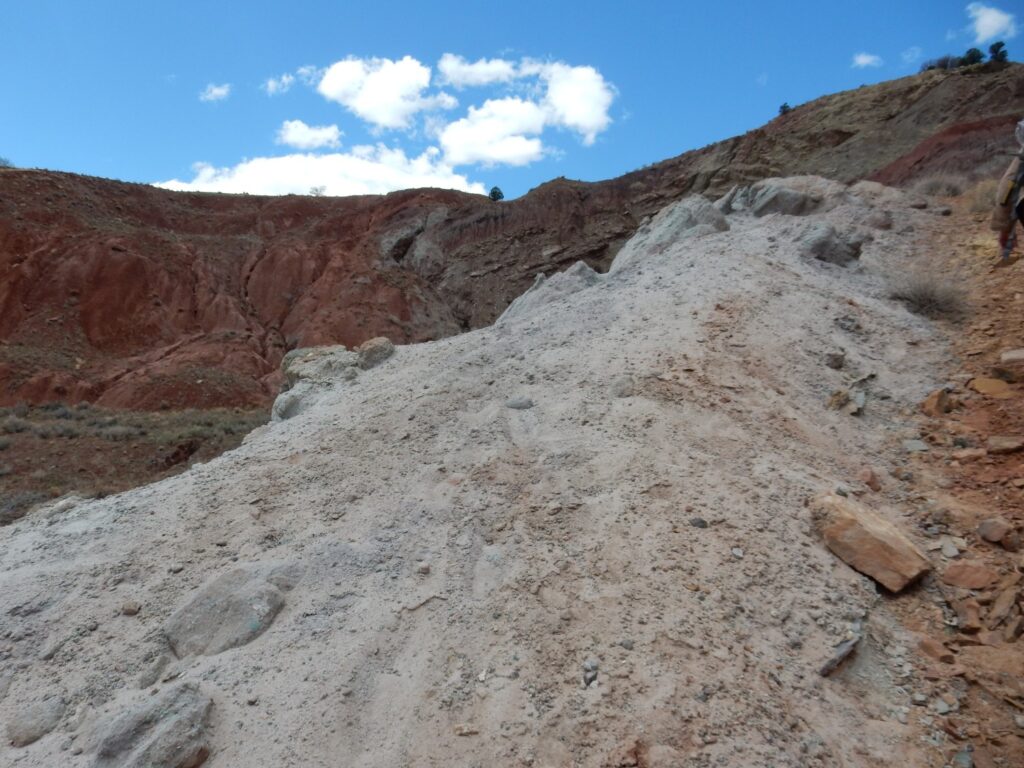
Beyond, the north cliffs of the open pit.
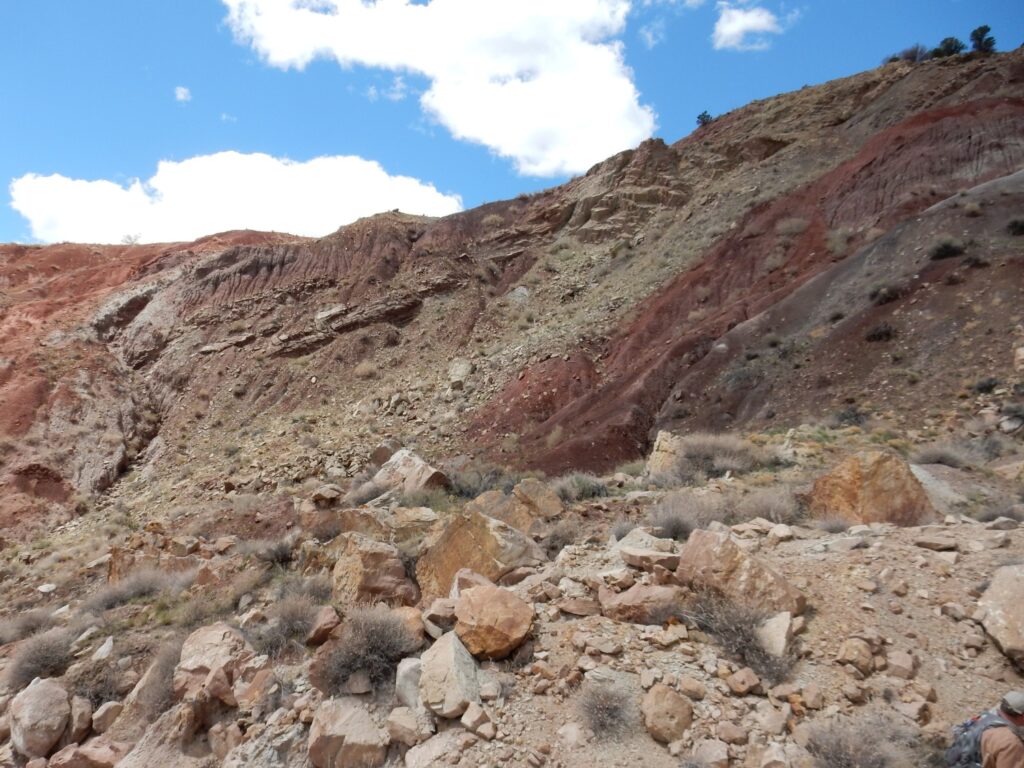
The sandstone beds at center are Poleo Formation, separating Petrified Forest Formation at left from Shinarump Formation at right.
We do find some nice stuff.
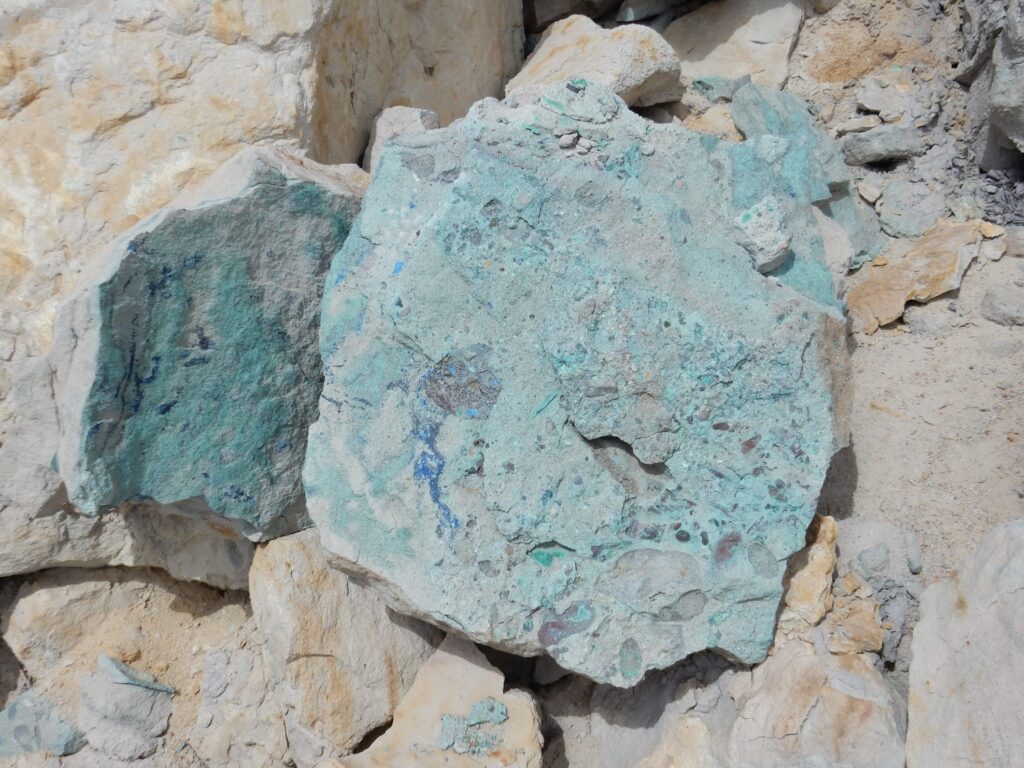
Notice the dark blue azurite. Azurite is unstable on geological time scales; it converts eventually to malachite. (Samples in a collection stored with normal care are safe.)
Gary is struck by what appear to be tool marks on a large boulder.
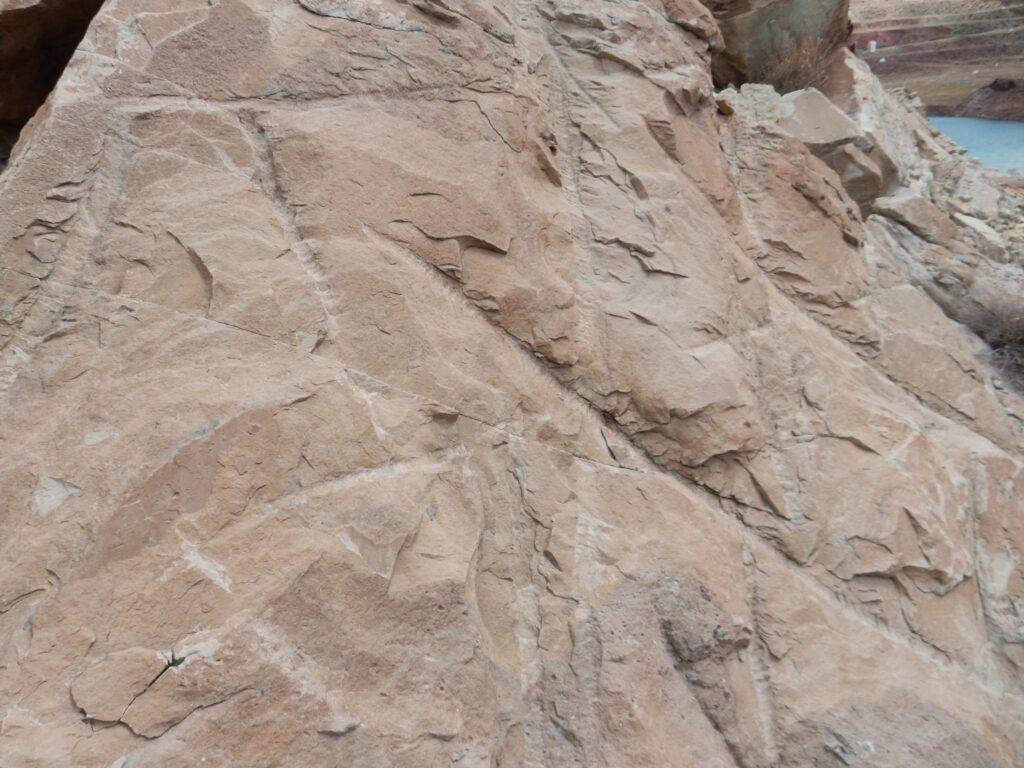
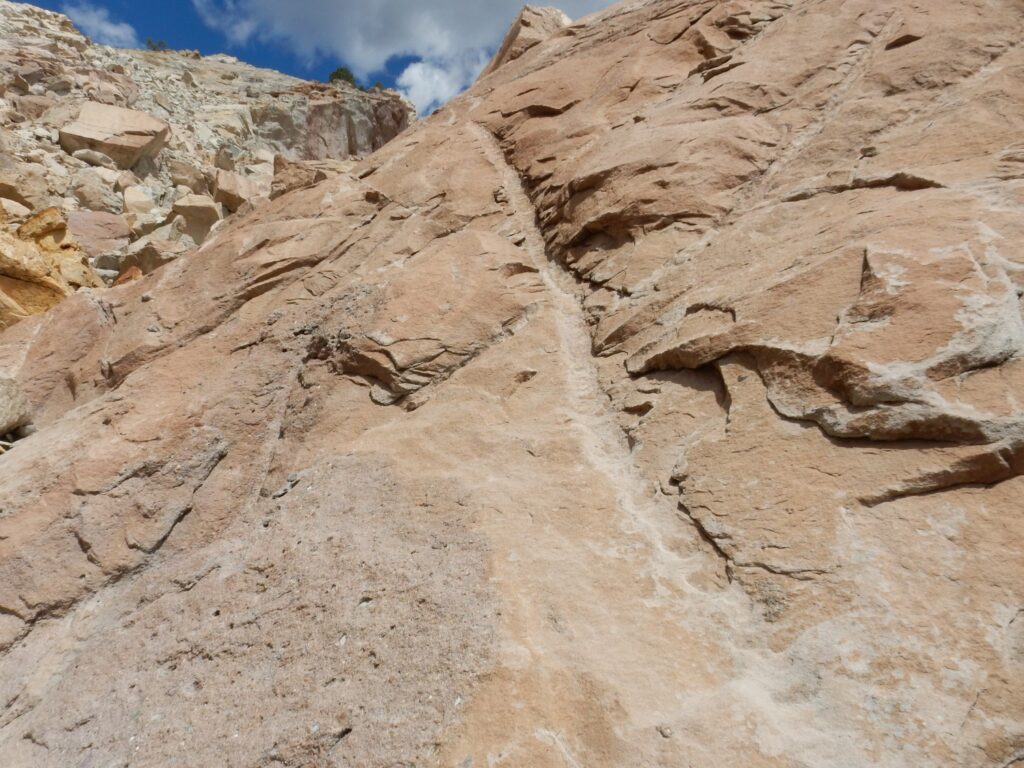
I don’t know what to make of them.
Some more lovely material.
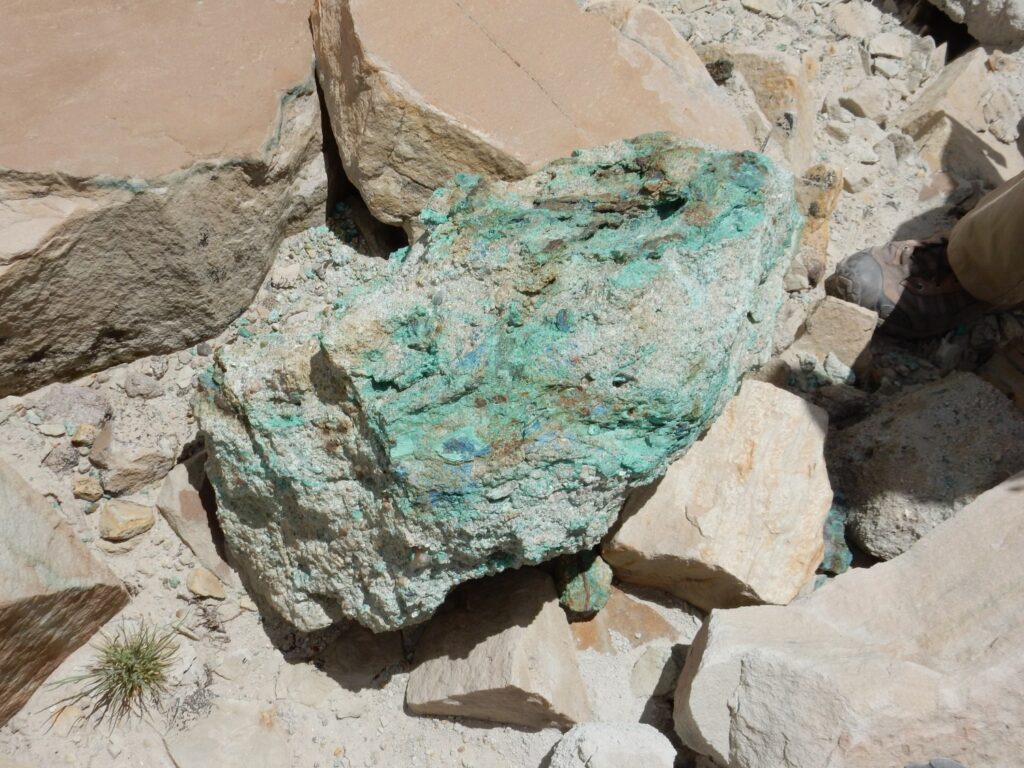
And some interesting sedimentary structures.
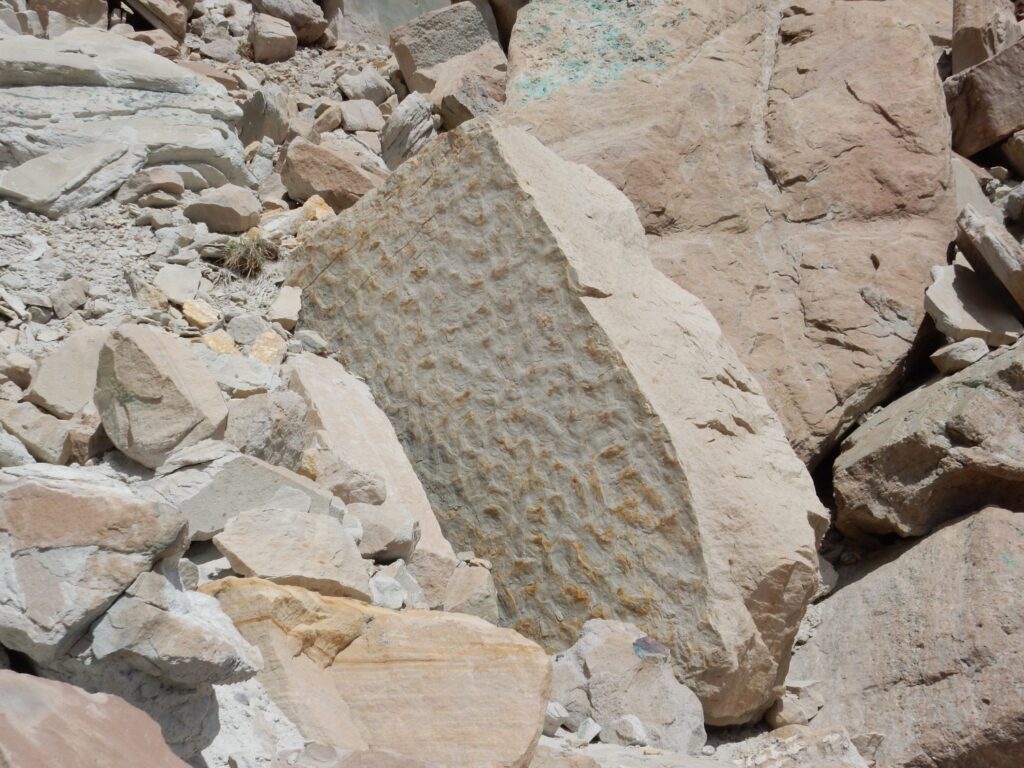
We pause for rehydration. I have to be careful to remember; my sense of thirst is defective and I get dehydrated easily.
There is some really gorgeous stuff up here.
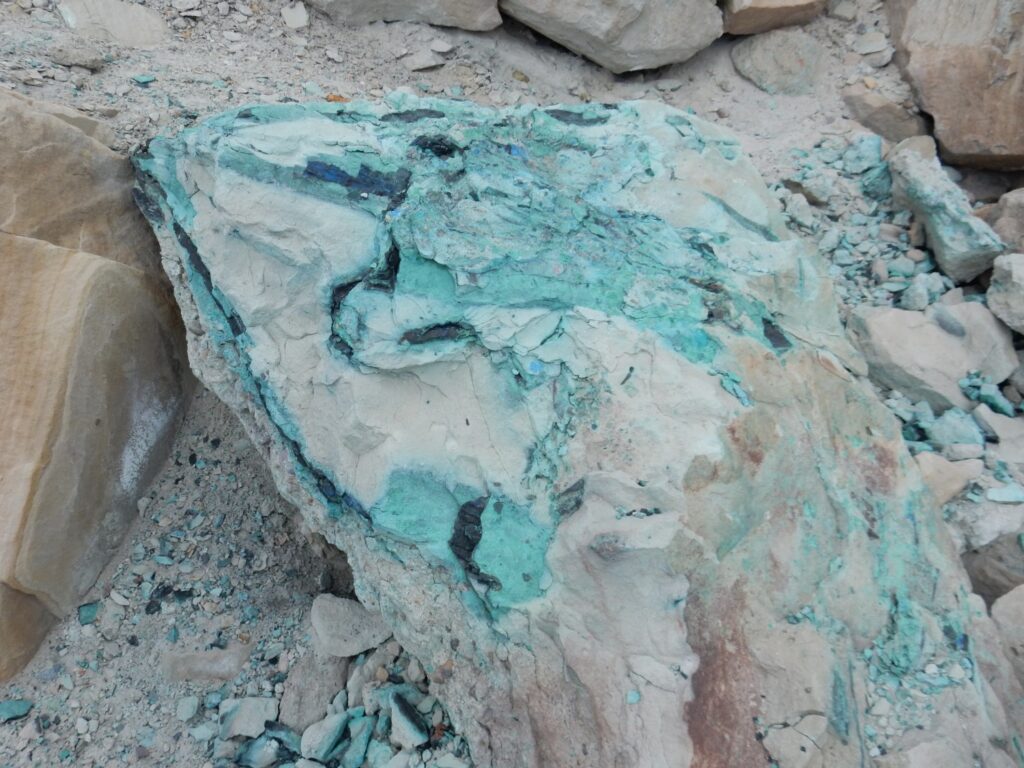
We hear some loud honking. We had seen a duck on the water earlier, but this sounds more like geese. Sure enough:
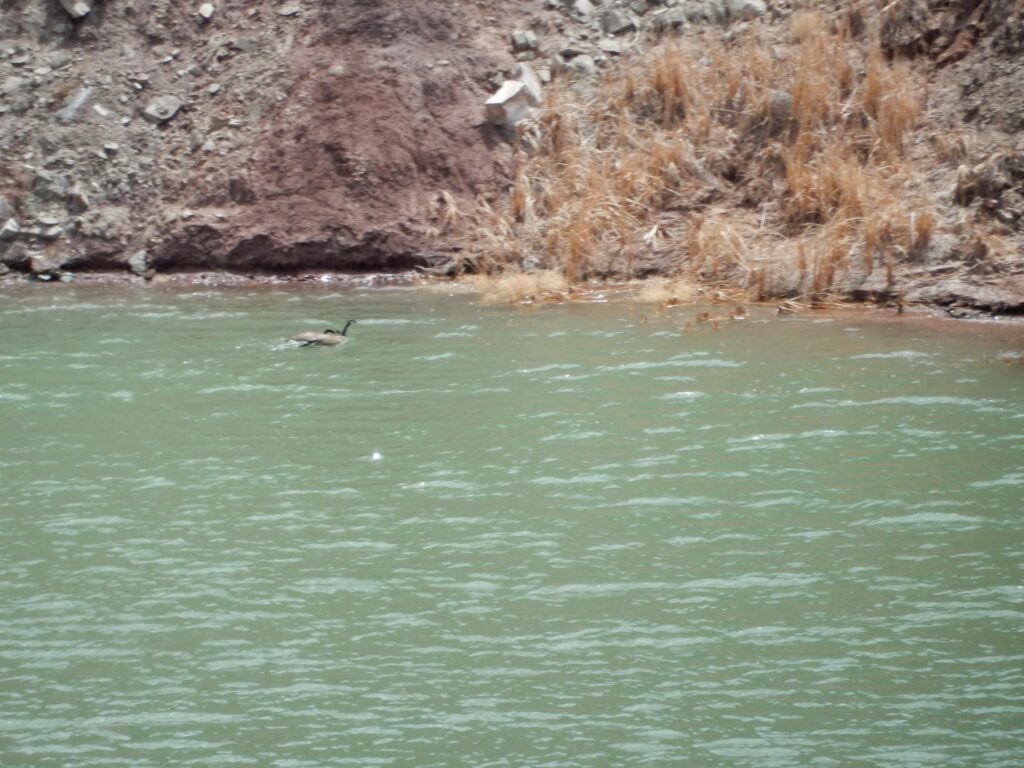
Deep telephoto shot; you may want to click to enlarge.
Just to the right.
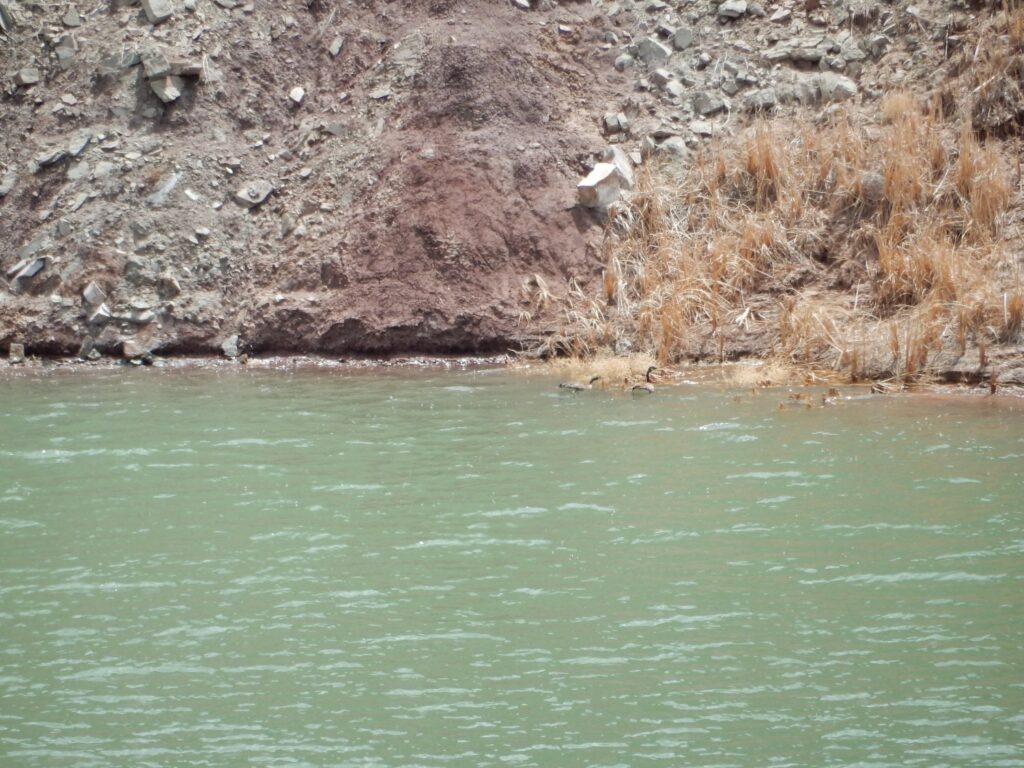
Canadian geese.
Gary checking out the treasures. In the background, the Poleo and Petrified Forest beds again.
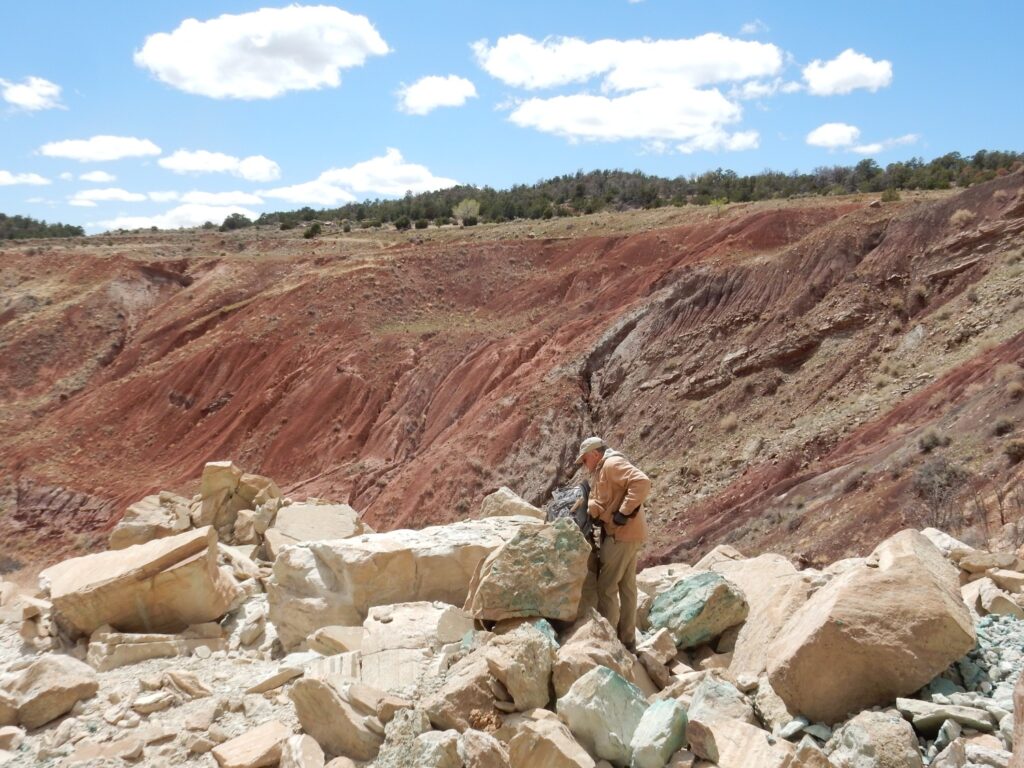
Crust.
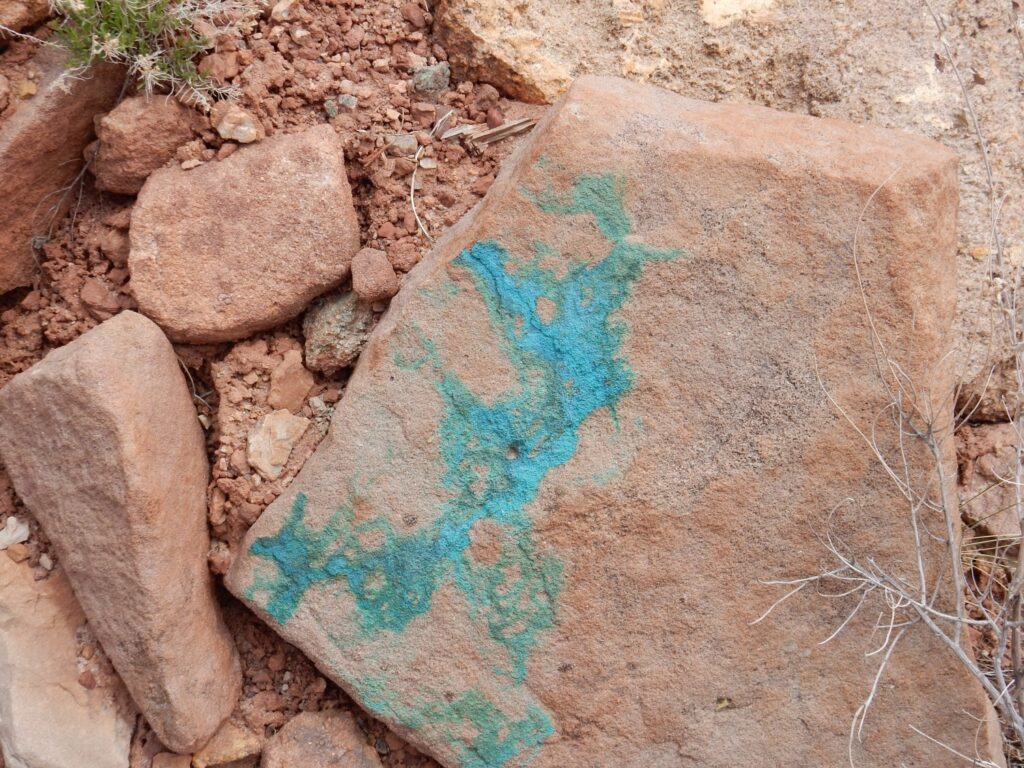
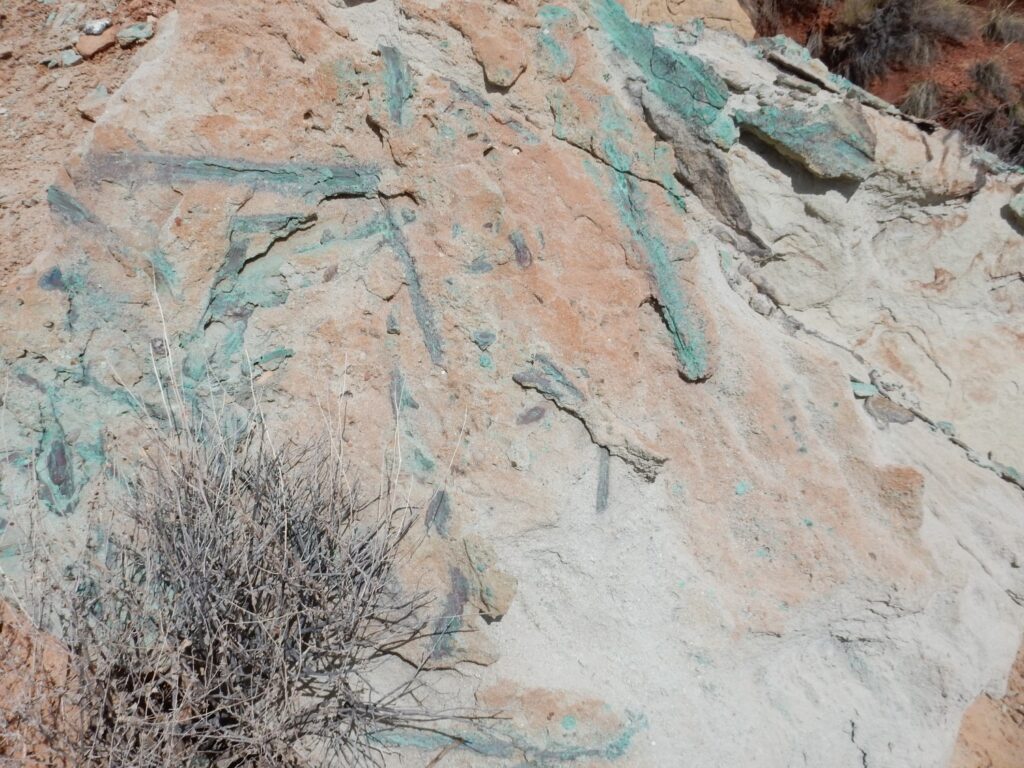
Meh, I lied. I did take a panorama, while stopping for a rest on the way out.

As with most images at this site, you can click to embiggen.
We head out. I take the first driving shift. About the time Gary is ready to take over, we come to a rather spectacular view, so I get a picture while changing seats.
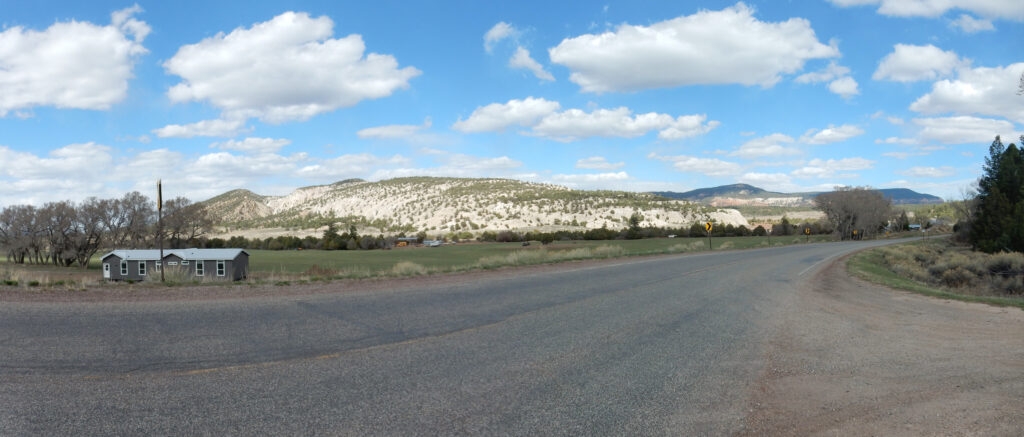
This is Cerro Blanco just west of Gallina, (Of course it is). It’s a hogback formed where beds of the Entrada Sandstone capped with gleaming gypsum beds of the Todilto Formation have been tiled out of the ground by tectonic forces. The gypsum is a record of a sabkha, or salt marsh, deposited some 165 million years ago.
A stop for shopping and then home.
Blogging may be a tad light this summer. I am finally making a serious effort to turn the book into an actual paper and ink book. I pulled everything into a Word document to start editing, and found I have 1800 distinct images and 2000 pages at the web site. Obviously I have some very serious editing to do. But it’s falling into place remarkably well. There are a lot of images I don’t really need. But getting the image count down to something someone is willing to print is nevertheless going to be wrenching. I’m sure I’ll have to leave out some images that are really pretty good.
TMI Warning
Meanwhile, I’ve just been diagnosed with normal tension glaucoma. I’ve already lost about 30% to 40% of the sight in one eye. The other is okay so far, though there are indications the underlying process is at work in both eyes. It looks like there is reason to be cautiously optimistic that treatment will prevent any further loss of sight, at least for many years. But it does give me a kick in the pants to get on with finishing the book, and a few other things I will need my eyes for. Prayers are appreciated, if that’s something you do.

Kent- Great write up and thanks for the discussion of the chemistry. I brought back a number of lovely samples, had a great day of exercise, and enjoyed the company. The black fossilized burnt wood samples are remarkably heavy, indicating that there is a large fraction of metal within.
Why is the water green?
Algae, maybe. Not copper contamination, according to the cleanup people.
Thanks for the detailed review of the field trip. Sorry about your eyes – prayers coming your way!